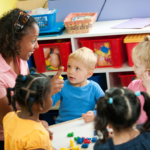Understanding Childhood Anxiety
Childhood anxiety is a common yet often misunderstood condition that affects many children today. It’s essential for parents, caregivers, and educators to recognize the signs of anxiety in children, as well as understand the underlying messages behind their behavior.
In this episode of Coffee with Consultants, mental health therapists Linda and Mariana discuss the signs of childhood anxiety, share some coping skills and give book recommendations for helping children with anxiety.
(Linda and Mariana are mental health consultants for preschool-age children through The Florida Center’s early childhood education program.)
Anxiety in children may manifest in various ways, and it’s important for adults to be aware of the following signs:
- Oppositional Behavior: Children experiencing anxiety may display increased defiance or opposition, seemingly out of character for them. They may resist participating in activities, refuse to follow instructions, or exhibit heightened irritability.
- Inflexible Thinking: Anxiety can lead to rigid and inflexible thinking patterns in children. They may struggle to adapt to changes, insist on specific routines, or become overly preoccupied with rules and order.
- Physical Ailments: Physical complaints such as headaches, stomachaches, or fatigue can often be manifestations of anxiety in children. These symptoms may appear even without any underlying medical conditions.
- Perfectionism: Children grappling with anxiety may exhibit perfectionistic tendencies. They may become overly self-critical, fear making mistakes, or exhibit excessive worry about their performance in various areas of life.
Equipping children with coping strategies empowers them to manage their anxiety in healthy ways. Here are some techniques that can prove beneficial:
- Positive Affirmations: Encourage your child to repeat positive affirmations to themselves regularly. These affirmations can help shift their mindset and foster a sense of self-confidence and resilience.
- Mindfulness: Introduce mindfulness practices to help children cultivate awareness of their thoughts and emotions. Guided meditation, deep breathing exercises, and body scans can aid in grounding and relaxation.
- Self-Regulation: Teach children to recognize and regulate their emotions. Encourage them to identify and express their feelings in healthy ways, such as through art, journaling, or engaging in physical activities.
- Challenging Negative Thoughts: Help children identify and challenge negative thoughts by teaching them to reframe negative self-talk. Encourage them to replace negative thoughts with positive and realistic alternatives.
Reading books can also be an effective tool to help children understand and manage their anxiety. Two recommended books on the topic are:
- “A Little Spot of Anxiety” by Diane Alber: This beautifully illustrated book explores the concept of anxiety in a relatable and accessible way, helping children understand their emotions and providing coping strategies.
- “Make Your Worrier a Warrior” by Dan Peters: This empowering book offers practical techniques for children to transform their anxiety into strength. It provides strategies for building resilience, self-confidence, and problem-solving skills.
Recognizing signs of anxiety in children and understanding their behaviors as a form of communication is crucial for their well-being. By equipping children with coping skills and introducing helpful resources like recommended books, we can support them in managing anxiety effectively and promote their overall mental health. Remember, a compassionate and supportive approach is key to helping children navigate their anxiety and build resilience for the future.


